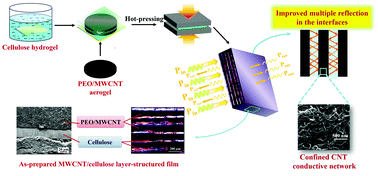Tunable electromagnetic interference shielding effectiveness via multilayer assembly of regenerated cellulose as a supporting substrate and carbon nanotubes/polymer as a functional layer†
Abstract
Hybrid systems integrating carbon nanotubes (CNTs) with cellulose showcase several key properties that can address emerging multifunctional needs, such as good electrical conductivity and electromagnetic interference (EMI) shielding. Herein, a subtle approach is accordingly developed to prepare CNTs/cellulose composite films that feature a layered structure consisting of a poly(ethylene oxide) (PEO)/CNTs layer as the EMI shielding layer and a regenerated cellulose layer as the supporting substrate. PEO acts as a robust enhancer of interfacial adhesion between the CNTs and the cellulose layers due to its favorable compatibility with cellulose chains, which is effective to prevent deterioration of the mechanical properties of the material; moreover, the high content of CNTs with trace amounts of PEO shows an extremely high electrical conductivity of 20 S cm−1. The layer-structured film shows an extremely high electrical conductivity of 20 S cm−1 and an excellent EMI shielding effectiveness (SE) of above 35 dB in the X-band, together with high tensile strength and a Young's modulus of 26.9 and 2615.4 MPa, respectively. Moreover, the composite shows extremely high specific SE (up to 1372.4 dB cm2 g−1) – an unprecedented result for CNT/cellulose materials. Comparatively, a plain-structured composite counterpart prepared via the normal direct-mixing process exhibits a much lower electrical conductivity of 2 S cm−1 and an inferior EMI shielding performance of 20 dB. Furthermore, the plain-structured composite suffers profound deterioration in mechanical strength and Young's modulus (12.4 and 1274.3 MPa, respectively). The film thickness and number of conducting layers significantly influence the EMI shielding performance, which indicates tunable EMI SE for this composite. Specifically, an increase in the total thickness leads to ultrahigh SE exceeding 65 dB. Although they have the same total thickness as monolayer films, a distinct enhancement in EMI SE for the multilayer films is clearly demonstrated, driven by the coherent multiple reflections at the internal interfaces of the conductive and cellulose layers. This study may provide a broader context for exploiting cellulose-based composite films with tunable electromagnetic interference shielding effectiveness; these films may find applications in portable electronic devices and radiation sources.



 Please wait while we load your content...
Please wait while we load your content...